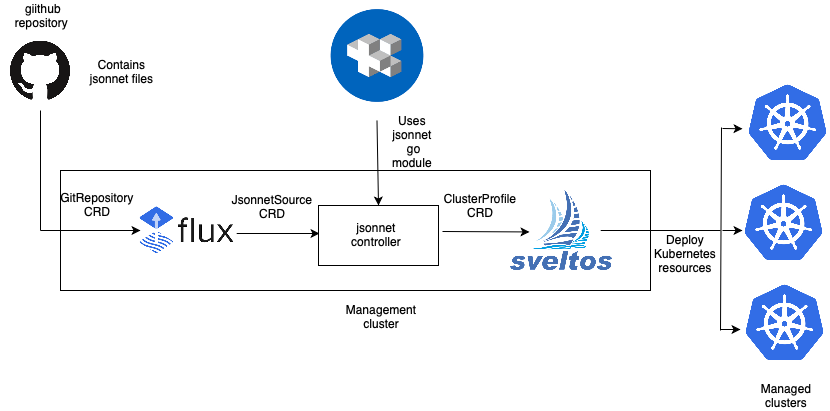Support for Jsonnet
What is JSONNET
jsonnet is a data templating language and configuration file format designed to simplify the creation and management of complex JSON or YAML data structures. It provides a concise and flexible syntax for generating JSON-like data by defining reusable templates, composing objects and arrays, and applying transformations.
If you want to use jsonnet in conjunction with Sveltos, you can install the jsonnet controller by performing the below:
$ kubectl apply -f https://raw.githubusercontent.com/gianlucam76/jsonnet-controller/main/manifest/manifest.yaml
The above command will install the necessary components for jsonnet controller.
The jsonnet controller offers the capability to process jsonnet files using different sources, such as Flux Sources (GitRepository/OCIRepository/Bucket), ConfigMap, or Secrets. It then programmatically invokes jsonnet go module and stores the output in the Status section making it available for Sveltos to consume.
Option 1: GitRepository

We can leverage GitRepository as a source for the jsonnet controller2. For example, in the provided GitHub repository jsonnet-examples, we can find the jsonnet files that Flux will sync.
To instruct the jsonnet controller to fetch files from this repository, create a JsonnetSource CRD instance with the below configuration:
---
apiVersion: extension.projectsveltos.io/v1beta1
kind: JsonnetSource
metadata:
name: jsonnetsource-flux
spec:
namespace: flux-system
name: flux-system
kind: GitRepository
path: ./variables/deployment.jsonnet
variables:
deploymentName: eng
namespace: staging
replicas: "3"
The path field specifies the location within the Git repository where the jsonnet file is stored. Once Flux detects changes in the repository and syncs it, the jsonnet-controller will automatically invoke the jsonnet module and store the output in the Status section of the JsonnetSource instance.
At this point, you can use the Sveltos' template feature to deploy the output of the jsonnet (Kubernetes resources) to a managed cluster. The Kubernetes add-on controller will take care of deploying it1.
ClusterProfile
Example - ClusterProfile and Resources Definition
---
apiVersion: config.projectsveltos.io/v1beta1
kind: ClusterProfile
metadata:
name: deploy-resources
spec:
clusterSelector:
matchLabels:
env: fv
templateResourceRefs:
- resource:
apiVersion: extension.projectsveltos.io/v1beta1
kind: JsonnetSource
name: jsonnetsource-flux
namespace: default
identifier: JsonnetSource
policyRefs:
- kind: ConfigMap
name: jsonnet-resources
namespace: default
---
apiVersion: v1
kind: ConfigMap
metadata:
name: jsonnet-resources
namespace: default
annotations:
projectsveltos.io/template: "true" # add annotation to indicate Sveltos content is a template
data:
resource.yaml: |
{{ (getResource "JsonnetSource").status.resources }}
The above configuration instructs Sveltos to deploy the resources generated by jsonnet to the selected managed clusters.
$ sveltosctl show addons
+-------------------------------------+-----------------+-----------+------+---------+-------------------------------+------------------+
| CLUSTER | RESOURCE TYPE | NAMESPACE | NAME | VERSION | TIME | CLUSTER PROFILES |
+-------------------------------------+-----------------+-----------+------+---------+-------------------------------+------------------+
| default/sveltos-management-workload | apps:Deployment | staging | eng | N/A | 2023-05-26 00:24:57 -0700 PDT | deploy-resources |
+-------------------------------------+-----------------+-----------+------+---------+-------------------------------+------------------+
Option 2: ConfigMap/Secret
Alternatively, you can use a ConfigMap/Secret as a source for the jsonnet controller
Step 1: Create a tarball containing the jsonnet files
$ tar -czf jsonnet.tar.gz -C ~mgianluc/go/src/github.com/gianlucam76/jsonnet-examples/multiple-files .
Step 2: Create a ConfigMap with the tarball
Step 3: Create a JsonnetSource instance that references this ConfigMap
---
apiVersion: extension.projectsveltos.io/v1beta1
kind: JsonnetSource
metadata:
name: jsonnetsource-configmap
spec:
namespace: default
name: jsonnet
kind: ConfigMap
path: ./main.jsonnet
variables:
namespace: production
Outcome will be same as seen above with Flux GitRepository:
apiVersion: extension.projectsveltos.io/v1beta1
kind: JsonnetSource
metadata:
annotations:
kubectl.kubernetes.io/last-applied-configuration: |
{"apiVersion":"extension.projectsveltos.io/v1beta1","kind":"JsonnetSource","metadata":{"annotations":{},"name":"jsonnetsource-configmap","namespace":"default"},"spec":{"kind":"ConfigMap","name":"jsonnet","namespace":"default","path":"./main.jsonnet","variables":{"namespace":"production"}}}
creationTimestamp: "2023-05-26T08:28:48Z"
generation: 1
name: jsonnetsource-configmap
namespace: default
resourceVersion: "121599"
uid: eea93390-771d-4176-92fe-2b761b803764
spec:
kind: ConfigMap
name: jsonnet
namespace: default
path: ./main.jsonnet
variables:
namespace: production
status:
resources: |
---
{"apiVersion":"apps/v1","kind":"Deployment","metadata":{"name":"my-deployment","namespace":"production"},"spec":{"replicas":3,"selector":{"matchLabels":{"app":"my-app"}},"template":{"metadata":{"labels":{"app":"my-app"}},"spec":{"containers":[{"image":"my-image:latest","name":"my-container","ports":[{"containerPort":8080}]}]}}}}
---
{"apiVersion":"v1","kind":"Service","metadata":{"name":"my-service","namespace":"production"},"spec":{"ports":[{"port":80,"protocol":"TCP","targetPort":8080}],"selector":{"app":"my-app"},"type":"LoadBalancer"}}
---
apiVersion: source.toolkit.fluxcd.io/v1
kind: GitRepository
metadata:
finalizers:
- finalizers.fluxcd.io
name: flux-system
namespace: flux-system
spec:
interval: 1m0s
ref:
branch: main
secretRef:
name: flux-system
timeout: 60s
url: ssh://git@github.com/gianlucam76/jsonnet-examples
-
Instructing Sveltos involves the initial step of retrieving a resource from the management cluster, which is the JsonnetSource instance named
jsonnetsource-fluxin thedefaultnamespace. Sveltos is then responsible for deploying the resources found within thejsonnet-resourcesConfigMap. However, this ConfigMap acts as a template, requiring instantiation before deployment. Within the Data section of the ConfigMap, there is a single entry calledresource.yaml. After instantiation, this entry will contain the content that the jsonnet controller has stored in the JsonnetSource instance. ↩ -
Flux is present in the management cluster and it is used to sync from GitHub repository. The GitRepository instance is the below. ↩